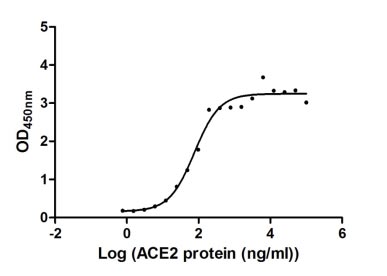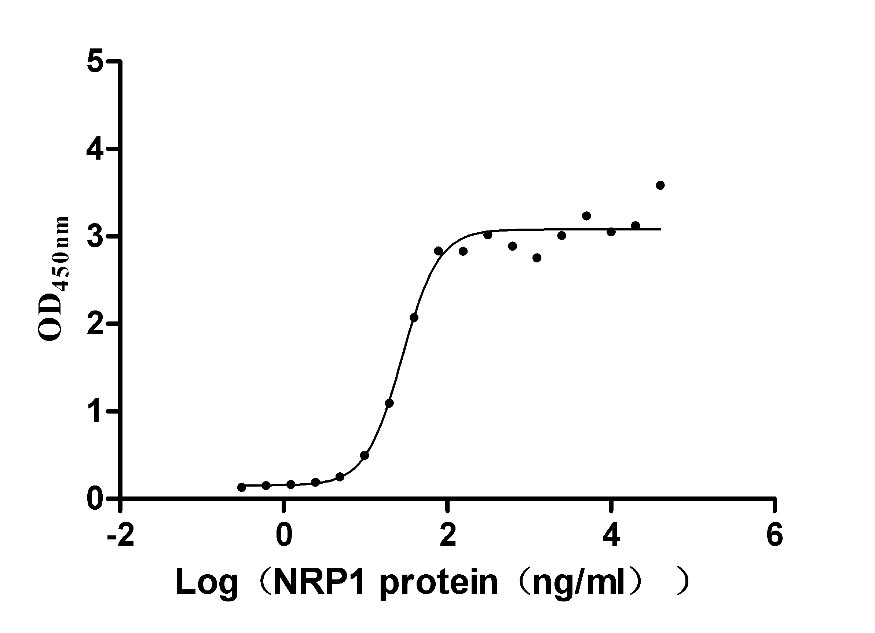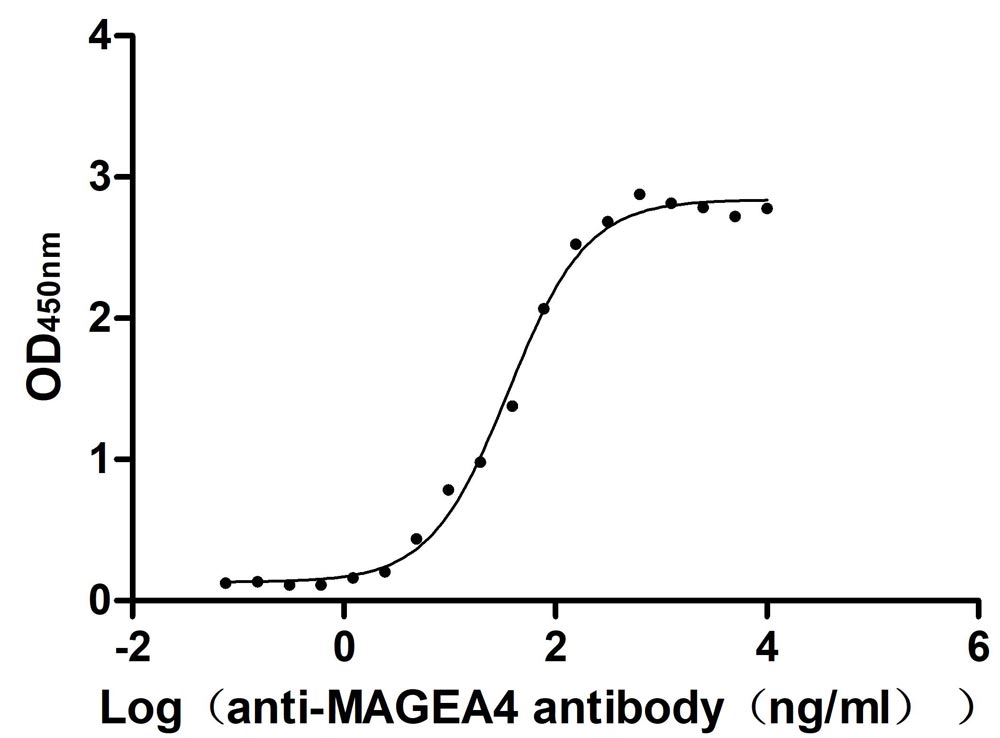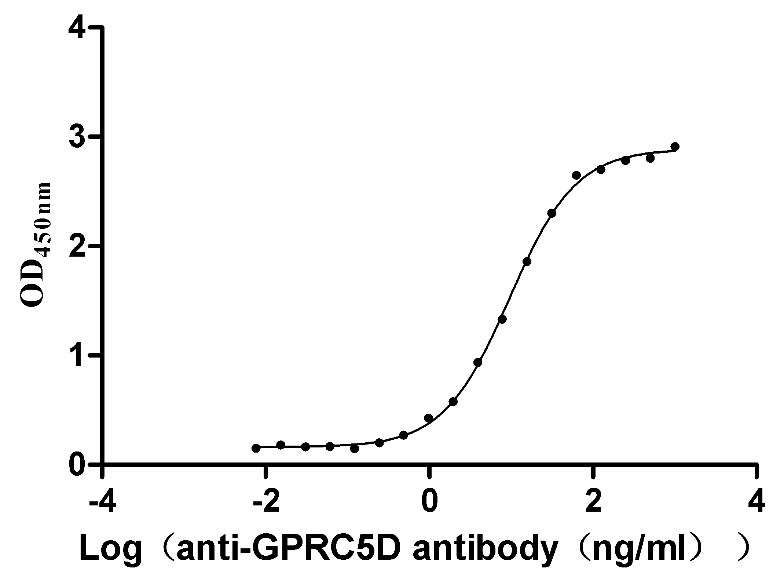Recombinant Mouse DNA damage-inducible transcript 3 protein (Ddit3)
-
中文名称:Recombinant Mouse DNA damage-inducible transcript 3 protein(Ddit3),Yeast
-
货号:CSB-YP006589MO
-
规格:
-
来源:Yeast
-
其他:
-
中文名称:Recombinant Mouse DNA damage-inducible transcript 3 protein(Ddit3),Yeast
-
货号:CSB-EP006589MO
-
规格:
-
来源:E.coli
-
其他:
-
中文名称:Recombinant Mouse DNA damage-inducible transcript 3 protein(Ddit3),Yeast
-
货号:CSB-EP006589MO-B
-
规格:
-
来源:E.coli
-
共轭:Avi-tag Biotinylated
E. coli biotin ligase (BirA) is highly specific in covalently attaching biotin to the 15 amino acid AviTag peptide. This recombinant protein was biotinylated in vivo by AviTag-BirA technology, which method is BriA catalyzes amide linkage between the biotin and the specific lysine of the AviTag.
-
其他:
-
中文名称:Recombinant Mouse DNA damage-inducible transcript 3 protein(Ddit3),Yeast
-
货号:CSB-BP006589MO
-
规格:
-
来源:Baculovirus
-
其他:
-
中文名称:Recombinant Mouse DNA damage-inducible transcript 3 protein(Ddit3),Yeast
-
货号:CSB-MP006589MO
-
规格:
-
来源:Mammalian cell
-
其他:
产品详情
-
纯度:>85% (SDS-PAGE)
-
基因名:
-
Uniprot No.:
-
别名:Ddit3; Chop; Chop10; Gadd153DNA damage-inducible transcript 3 protein; DDIT-3; C/EBP zeta; C/EBP-homologous protein; CHOP; C/EBP-homologous protein 10; CHOP-10; CCAAT/enhancer-binding protein homologous protein; Growth arrest and DNA-damage-inducible protein GADD153
-
种属:Mus musculus (Mouse)
-
蛋白长度:Full length protein
-
表达区域:1-168
-
氨基酸序列MAAESLPFTL ETVSSWELEA WYEDLQEVLS SDEIGGTYIS SPGNEEEESK TFTTLDPASL AWLTEEPGPT EVTRTSQSPR SPDSSQSSMA QEEEEEEQGR TRKRKQSGQC PARPGKQRMK EKEQENERKV AQLAEENERL KQEIERLTRE VETTRRALID RMVSLHQA
-
蛋白标签:Tag type will be determined during the manufacturing process.
The tag type will be determined during production process. If you have specified tag type, please tell us and we will develop the specified tag preferentially. -
产品提供形式:Lyophilized powder
Note: We will preferentially ship the format that we have in stock, however, if you have any special requirement for the format, please remark your requirement when placing the order, we will prepare according to your demand. -
复溶:We recommend that this vial be briefly centrifuged prior to opening to bring the contents to the bottom. Please reconstitute protein in deionized sterile water to a concentration of 0.1-1.0 mg/mL.We recommend to add 5-50% of glycerol (final concentration) and aliquot for long-term storage at -20℃/-80℃. Our default final concentration of glycerol is 50%. Customers could use it as reference.
-
储存条件:Store at -20°C/-80°C upon receipt, aliquoting is necessary for mutiple use. Avoid repeated freeze-thaw cycles.
-
保质期:The shelf life is related to many factors, storage state, buffer ingredients, storage temperature and the stability of the protein itself.
Generally, the shelf life of liquid form is 6 months at -20°C/-80°C. The shelf life of lyophilized form is 12 months at -20°C/-80°C. -
货期:Delivery time may differ from different purchasing way or location, please kindly consult your local distributors for specific delivery time.Note: All of our proteins are default shipped with normal blue ice packs, if you request to ship with dry ice, please communicate with us in advance and extra fees will be charged.
-
注意事项:Repeated freezing and thawing is not recommended. Store working aliquots at 4°C for up to one week.
-
Datasheet :Please contact us to get it.
靶点详情
-
功能:Multifunctional transcription factor in endoplasmic reticulum (ER) stress response. Plays an essential role in the response to a wide variety of cell stresses and induces cell cycle arrest and apoptosis in response to ER stress. Plays a dual role both as an inhibitor of CCAAT/enhancer-binding protein (C/EBP) function and as an activator of other genes. Acts as a dominant-negative regulator of C/EBP-induced transcription: dimerizes with members of the C/EBP family, impairs their association with C/EBP binding sites in the promoter regions, and inhibits the expression of C/EBP regulated genes. Positively regulates the transcription of TRIB3, IL6, IL8, IL23, TNFRSF10B/DR5, PPP1R15A/GADD34, BBC3/PUMA, BCL2L11/BIM and ERO1L. Negatively regulates; expression of BCL2 and MYOD1, ATF4-dependent transcriptional activation of asparagine synthetase (ASNS), CEBPA-dependent transcriptional activation of hepcidin (HAMP) and CEBPB-mediated expression of peroxisome proliferator-activated receptor gamma (PPARG). Together with ATF4, mediates ER-mediated cell death by promoting expression of genes involved in cellular amino acid metabolic processes, mRNA translation and the unfolded protein response (UPR) in response to ER stress. Inhibits the canonical Wnt signaling pathway by binding to TCF7L2/TCF4, impairing its DNA-binding properties and repressing its transcriptional activity. Plays a regulatory role in the inflammatory response through the induction of caspase-11 (CASP4/CASP11) which induces the activation of caspase-1 (CASP1) and both these caspases increase the activation of pro-IL1B to mature IL1B which is involved in the inflammatory response. Acts as a major regulator of postnatal neovascularization through regulation of endothelial nitric oxide synthase (NOS3)-related signaling.
-
基因功能参考文献:
- Endoplasmic reticulum stress-induced activation of CHOP suppresses intestinal stem cell proliferation and intestinal epithelial cell renewal, which leads to disruption of intestinal barrier function, massive bacterial translocation, activation of kupffer cells, and periportal inflammation and, eventually, results in fibrosis in the liver PMID: 28926118
- Liver ischemia reperfusion injury induces CHOP expression, and CHOP deficiency attenuates liver IRI by inhibiting apoptosis. PMID: 29524333
- Study indicates that CHOP deficiency protects against Western diet-induced AoV calcification in Apoe(-/-) mice. CHOP deficiency prevents oxLDL-induced VIC osteoblastic differentiation via preventing VIC-derived ABs releasing. PMID: 28891115
- these results suggest that CHOP plays a critical role in the progression of kidney fibrosis, likely through regulation of autophagy and apoptosis. PMID: 29425932
- These results suggest JUN and DDIT3 are independently regulated pro-death signaling molecules in retinal ganglion cells and together account for the vast majority of apoptotic signaling in retinal ganglion cells after axonal injury PMID: 28969695
- We demonstrated that PPARalpha activation contributes to liver protection and decreases liver inflammation in acute liver failue (ALF), particularly through regulating CHOP. Our findings may provide a rationale for targeting PPARalpha as a potential therapeutic strategy to ameliorate ALF. PMID: 28600667
- This study was undertaken to explore the mechanism whereby ERK5 inhibition instigates pancreatic beta-cell apoptosis via an endoplasmic reticulum stress-dependent signaling pathway. PMID: 28681594
- ER stress is induced early in EAE and that modulation of ER stress by inhibition of eIF2alpha-CHOP and activation of XBP-1 in RGC specifically, protects RGC somata and axons and preserves visual function. PMID: 28726788
- Constitutive overexpression of the CHOP protein does not induce apoptosis in myelinating glia of the central and peripheral nervous systems PMID: 27335410
- Activation of the ER stress execution proteins, PERK and CHOP10, was evaluated to determine whether this process was involved in 15d-PMJ2 cell death. 15d-PMJ2 increased the phosphorylation of PERK and expression of CHOP10 in tumorigenic but not nontumorigenic cells PMID: 28292936
- Chop was found to exacerbate allergic airway inflammation by enhancing M2 programming in macrophages PMID: 28238747
- Our findings support that CHOP may be an important signaling molecule in the progression of chronic kidney disease PMID: 26942460
- GPR4 blockade attenuated renal injury after IR and reduced the cell apoptosis through the suppression of CHOP expression. PMID: 29089376
- CHOP deficiency prevents HFD-induced insulin resistance. PMID: 28228268
- Endoplasmic reticulum stress-induced CHOP activation in the brain is a mechanistic link in the palmitate-induced negative regulation of leptin and IGF1. PMID: 27555288
- a significant protein-protein interaction between GR and CHOP, (GR-CHOP heterocomplex formation) under endoplasmic reticulum stress conditions, is reported. PMID: 27496643
- The study shows that FXR/RXR regulates Chop expression in a mouse model of steatohepatitis, providing novel insights into pathogenesis of this disorder. PMID: 28895119
- Ddit3 suppresses the differentiation of ATDC5 cells PMID: 27845261
- Free CNPY2 then engages protein kinase R-like endoplasmic reticulum kinase (PERK) to induce expression of the transcription factor C/EBP homologous protein (CHOP), thereby initiating the unfolded protein response. PMID: 28869608
- SHP and REV-ERBalpha play a critical role in controlling rhythmic CHOP expression in alcoholic fatty liver PMID: 27664470
- Upregulating HSF1 relieves the tau toxicity in N2a-TauRD DeltaK280 by reducing CHOP and increasing HSP70 a5 (BiP/GRP78). Our work reveals how the bidirectional crosstalk between the two stress response systems promotes early tau pathology and identifies HSF1 being one likely key player in both systems. PMID: 28678786
- Study showed that Chop is involved in the pathogenesis of pulmonary fibrosis by regulating the generation of M2 macrophages and TGF-beta signaling. PMID: 26883801
- AMPKalpha1 mediates CHOP ubiquitination and proteasomal degradation in macrophages by promoting the phosphorylation of CHOP at serine 30. Transfection of Chop-specific siRNA but not control siRNA reduced both CHOP level and injury-induced neointimal disruption in vivo. PMID: 27650555
- The data presented indicate that the unfolded protein response is activated in fibrotic lung tissue and strongly localized to macrophages. GRP78- and CHOP-mediated macrophage apoptosis was found to protect against bleomycin-induced fibrosis. PMID: 27135434
- Deletion of CHOP attenuates dysfunction of the autophagy/lysosomal pathway in beta-cells of transgenic mice. PMID: 26900721
- this study demonstrates novel roles for the endoplasmic reticulum stress-response transducer PERK and a downstream effector of its activation, CHOP, in tubule cell production of fibronectin PMID: 26483256
- CHOP regulates not only apoptosis-related signaling but also ROS formation and inflammation in renal tubular cells during ischemia/reperfusion (I/R). CHOP may play an important role in the pathophysiology of I/R-induced renal injury. PMID: 25178318
- As a dual function cytokine, IL-1alpha may contribute to the induction of CHOP intracellularly, while IL-1alpha released from necrotic cells accelerates steatohepatitis via induction of inflammatory cytokines by neighboring cells. PMID: 26022690
- CHOP expression in myeloid cells plays an important role in determining the magnitude and duration of inflammatory response in vivo by modulating expression of proinflammatory cytokines such as IL-6 in infiltrating macrophages. PMID: 26134251
- the ER stress-induced transcription factor, CHOP, at least in part, plays an important role in the development of bleomycin-induced pulmonary fibrosis PMID: 26005208
- Data indicate that transcription factor Chop does not play a significant causal role during retinal degeneration. PMID: 26427410
- Upregulation of PD-1 and PD-L1 was associated with marked increases in GADD153 during myocardial ischemic reperfusion injury. PMID: 25902191
- Chop deficiency prevents unilateral ureteral obstruction-induced renal fibrosis by attenuating fibrotic signals originated from Hmgb1/TLR4/NFkappaB/IL-1beta signaling. PMID: 26247732
- findings suggest that the balance between XBP1-mediated adaptive and CHOP-dependent apoptotic UPR is critically important for beta-cell survival during ER stress. PMID: 26135354
- The enrichment of Gata2 target genes in Ddit3-dependent transcriptional responses suggests that Ddit3 functions in an erythroid transcriptional network nucleated by Gata2. PMID: 26051941
- knockdown of a proton-sensing G protein-coupled receptor GPR4 markedly reduced CHOP expression and endothelial cell apoptosis after hypoxia exposure. PMID: 25343248
- NR4A1 protects pancreatic beta-cells against endoplasmic reticulum stress-mediated apoptosis by up-regulating Survivin expression and down-regulating CHOP expression. PMID: 26157144
- With the development of diabetes, the expression of GRP78 decreases while the expression of UPR-associated proapoptotic transcriptional regulator C/EBP homologous protein (CHOP) increases. PMID: 25529350
- these data show that IEC-specific overexpression impairs epithelial cell proliferation and mucosal tissue regeneration, suggesting an important role for CHOP beyond mediating apoptosis. PMID: 24850428
- Data imply the involvement of ER stress/CHOP signaling in CVB3-induced acute viral myocarditis via proapoptotic pathways. PMID: 25985795
- Ablation of CHOP does not ameliorate cardiac remodeling induced by permanent myocardial infarction. PMID: 26111448
- Data show that vascular smooth muscle cells (VSMCs)-C/EBP-homologous protein (CHOP) deficiency decreases the proliferation of aortic explant-dderived VSMCs. PMID: 25872946
- Palmitate-induced apoptosis requires maximal expression of CHOP which is achieved via the downregulation of its repressive microRNA, miR-615-3p. PMID: 25314137
- Data (including data from knockout mice) suggest that up-regulation of expression of CHOP (c/EBP-homologous protein) and ERO1alpha (oxidoreductin-1-L-alpha) is involved in liver apoptosis/necrosis exhibited in acute liver failure. PMID: 25387528
- Fibroblasts from two long-lived mice mutants (Snell dwarf and PAPP-A knockout) expressed higher levels of Chop (a ATF4 target gene) during stress, suggesting a connection to longevity. PMID: 24691093
- Endoplasmic reticulum stress-induced apoptosis contributes to articular cartilage degeneration via C/EBP homologous protein. PMID: 24795271
- Absence of CHOP partially protects against RGC loss and reduction in retinal function after I/R injury, indicating that CHOP and, thus, ER stress play an important role in RGC apoptosis in retinal I/R injury. PMID: 25414185
- a role for CHOP as a positive regulator of carcinogen-induced HCC progression PMID: 24339898
- Suppression of CHOP impaired the transcriptional activation of FGF21. PMID: 24900988
- following amino acid starvation there is a highly coordinated sequential program of molecular events involving CHOP and leading first to autophagy and then to apoptosis if stress is prolonged. PMID: 24657471
显示更多
收起更多
-
亚细胞定位:Cytoplasm. Nucleus.
-
蛋白家族:BZIP family
-
数据库链接:
KEGG: mmu:13198
STRING: 10090.ENSMUSP00000026475
UniGene: Mm.110220
Most popular with customers
-
Recombinant Human Angiotensin-converting enzyme 2 (ACE2), partial (Active)
Express system: Mammalian cell
Species: Homo sapiens (Human)
-
Recombinant Human Semaphorin-4D (SEMA4D), partial (Active)
Express system: Mammalian cell
Species: Homo sapiens (Human)
-
Recombinant Human Neuropilin-1 (NRP1) (Active)
Express system: Mammalian cell
Species: Homo sapiens (Human)
-
Recombinant Human Insulin growth factor-like family member 1 (IGFL1) (Active)
Express system: Mammalian cell
Species: Homo sapiens (Human)
-
Recombinant Human Melanoma-associated antigen 4 (MAGEA4) (Active)
Express system: Mammalian cell
Species: Homo sapiens (Human)
-
Recombinant Human G-protein coupled receptor family C group 5 member D (GPRC5D)-VLPs (Active)
Express system: Mammalian cell
Species: Homo sapiens (Human)
-
Recombinant Mouse Transthyretin (Ttr) (Active)
Express system: Mammalian cell
Species: Mus musculus (Mouse)
-
Express system: Mammalian cell
Species: Homo sapiens (Human)




















